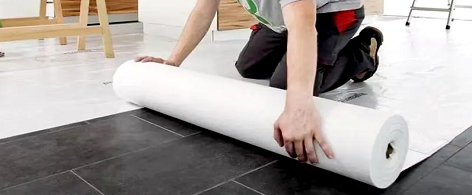Cat:Glue -coated Protective Film
One single flaw is enough to change a “superior” product to “inferior”and thus perfect products need good protection. How you protect your valuable ca...
See Details
What Makes Non-Woven Protection Fabric Durable?
Non-woven protection fabrics are durable because of their unique manufacturing process. They can withstand stress and wear in harsh environments better than traditional woven fabrics. The durability of non-woven fabrics has led to their widespread use in many demanding industries.
Key Durability Features:
Tear Resistance
Non-woven fabrics are more resistant to tearing and abrasion than traditional woven fabrics. Woven fabrics are often prone to breaking when subjected to tension, while non-woven fabrics have much greater resistance to stretch and tearing because their fibers are bonded together. Non-woven protection fabrics can last longer in high-intensity or high-friction environments.
Water Resistance
Many non-woven fabrics can be treated with a water-repellent treatment during the manufacturing process, making them effectively resistant to water penetration. This property makes them ideal for use in wet or humid environments. For example, non-woven fabrics are used in the medical industry to make waterproof surgical gowns and surgical covers to prevent liquid contamination.
Chemical Resistance
Another important advantage of non-woven fabrics is their chemical resistance. Certain types of nonwoven fabrics have strong chemical resistance in environments with high chemical exposure. For example, protective clothing used in industrial cleaning work often uses such fabrics to protect the wearer from chemicals.

Versatility in Application
The versatility of nonwoven protective fabrics has led to their widespread use in multiple industries. Whether it is medical devices, automotive parts, or agricultural protection, nonwoven fabrics can meet different performance requirements. By tailoring different fabric properties, nonwoven fabrics can adapt to a variety of application scenarios.
Common Applications (Common Applications):
Healthcare (Medical Industry)
In the medical industry, nonwoven fabrics are ideal for making personal protective equipment (PPE) due to their breathability, comfort and protective properties. It is widely used in products such as surgical gowns, masks, and surgical pads. Nonwoven fabrics provide an effective barrier to prevent the invasion of bacteria, viruses, and other microorganisms while also maintaining the comfort of the wearer.
Automotive Industry (Automotive Industry)
In automotive manufacturing, nonwoven fabrics are used in various aspects of vehicle interiors, including seat padding, sound insulation, filters, etc. Due to their lightweight and durable characteristics, nonwoven fabrics can effectively reduce noise in the car, improve comfort, and provide additional safety in certain parts.
Agriculture
Nonwoven fabrics are also widely used in the agricultural field, especially in crop protection. For example, nonwoven fabrics can be used to cover crops to protect against cold, strong winds, and pests. Nonwoven fabrics are also used as weed barriers to reduce the growth of weeds in farmland and protect crops from competition.
Packaging
Nonwoven fabrics are also used in the packaging industry, especially in packaging to protect fragile items. It can be customized into different shapes, thicknesses, and functions to protect products in transit from external impact and environmental pollution. Compared with traditional packaging materials, nonwoven fabrics are generally lighter and have stronger pressure resistance.
Advantages of Non-Woven Protection Fabric
In addition to its durability and versatility, nonwoven protection fabrics have many other advantages over traditional woven fabrics. These advantages make it a preferred material in multiple industries.
Lightweight and Breathable
Nonwoven fabrics are usually lighter than traditional fabrics, which means they provide better comfort, especially when used in personal protective equipment. For example, medical masks and protective clothing use nonwoven fabrics to maintain sufficient breathability, so that the wearer does not feel uncomfortable even if they wear them for a long time.
Cost-Effective
Nonwoven fabrics are usually produced in a simpler and faster way than traditional woven fabrics, which makes them cheaper to produce. For industries that produce in large quantities and require high cost-effectiveness, nonwoven protective fabrics provide an economical and practical solution.
Customization
Nonwoven fabrics are manufactured in a very flexible way and can be customized according to needs. For example, the performance of the fabric can be adjusted by changing the type, density and number of layers of fibers. Nonwoven fabrics can also be added with additional functions such as antibacterial, flame retardant, and UV resistance according to application requirements to meet the requirements of specific industries.